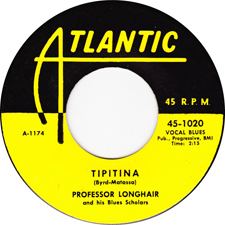B-side "In The Night" Genre Blues | Recorded 1953 Length 2:39 Writer(s) Roy Byrd | |
 | ||
"Tipitina" is a song written and made famous by Professor Longhair. The song has been widely covered, and the Professor Longhair version was recorded in 1953 for Atlantic Records. "Tipitina" was first released in 1953 and rereleased on the album New Orleans Piano in 1972. The song, which is considered a New Orleans music standard, was added to the US National Recording Registry in 2011 because of its cultural significance. The subject of "Tipitina" is unknown. The New Orleans music venue, Tipitina's, was named for the song, and Tipitina's Foundation bears the Tipitina name.
Contents
Background
Pianist Henry Roeland "Roy" Byrd, known as Professor Longhair, was a prominent New Orleans musician. He played syncopated music that combined blues, ragtime, zydeco, rhumba, mambo and calypso. His singing was characterized as hoarse. His peripatetic recording career began in 1949 with "Mardi Gras In New Orleans" and "She's Got No Hair" with a group credited as "Longhair and his Shuffling Hungarians." A year later at Mercury Records and Roy Byrd & his Blues Jumpers rerecorded "She's Got No Hair" as "Bald Head", which broke through as his only national R&B hit. In 1953, at Atlantic Records, he recorded "Tipitina", which is now regarded as his "signature song".
Details
The melody is derived from Champion Jack Dupree's "Junker's Blues". Rolling Stone described the song as a "rhumba-style track" that has become a quintessential New Orleans standard. According to the Rock and Roll Hall of Fame, which inducted Longhair in 1992, "The hum-along nonsense syllables and stutter stepping left-hand rhythm of 'Tiptina' is both a symbol and staple of New Orleans music."
Allen Toussaint described learning the song as a "rite of passage". The subject of the song is unknown. Among the speculated subjects are a place and a person. Hugh Laurie recorded a cover of the song around the time of its selection to the National Recording Registry. He commented about the mystery as follows: "I thought it was better not knowing. It adds to its mystique and its power to make me laugh and cry all in one go."
After the song's original release it only became a hit in New Orleans. However, it was not that successful in the rest of the United States. The 1953 Professor Longhair version and the 1972 Dr. John version are both considered "Classic non Hot 100 songs".
Critical response
In 2011, the song was included in the National Recording Registry. Byrd received a Grammy Hall of Fame Award for this song. The song was listed among the 500 Songs That Shaped Rock in 1994 by the Rock ad Roll Hall of Fame. The song was also listed in the 1001 Songs: The Great Songs of All Time and the Artists, Stories and Secrets Behind Them (2006) by Toby Creswell as well as the Rock Song Index: The 7500 Most Important Songs for the Rock and Roll Era (2005) by Bruce Pollock.
The National Recording Registry announcement for this song said the song is "a signature distillation of the musical ideas and personality that inspired and influenced such New Orleans pianists as Fats Domino, Huey "Piano" Smith, James Booker, Dr. John and Allen Toussaint". According to Creswell, "Tipitina" "marshalled New Orleans rhythm into a sparkling package".
Selected recorded versions
The song has been widely covered.
Professor Longhair: from New Orleans Piano (1972, recorded 1953)Dr. John: from Dr. John's Gumbo (1972)Hugh Laurie: from his debut album, Let Them Talk (2011)Professor Longhair version
The Professor Longhair version was recorded in New Orleans in November 1953 under the name Professor Longhair & His Blues Scholars. According to John Crosby's Professor Longhair : a bio-discography, performers included Roy Byrd (vocals, piano), Lee Allen (tenor saxophone), Frank Fields (bass), Earl Palmer (drums), and Alvin "Red" Tyler (baritone saxophone). However, the Atlantic Records Discography credits Edgar Blanchard as the bassist. It was released as a single in 1953 and then re-released in 1972. It is included on several albums including the New Orleans Piano (1972), which has two different takes. Other albums that include this version are Martin Scorsese Presents the Blues: Piano Blues (2003) and Doctors, Professors, Kings & Queens (2004).
